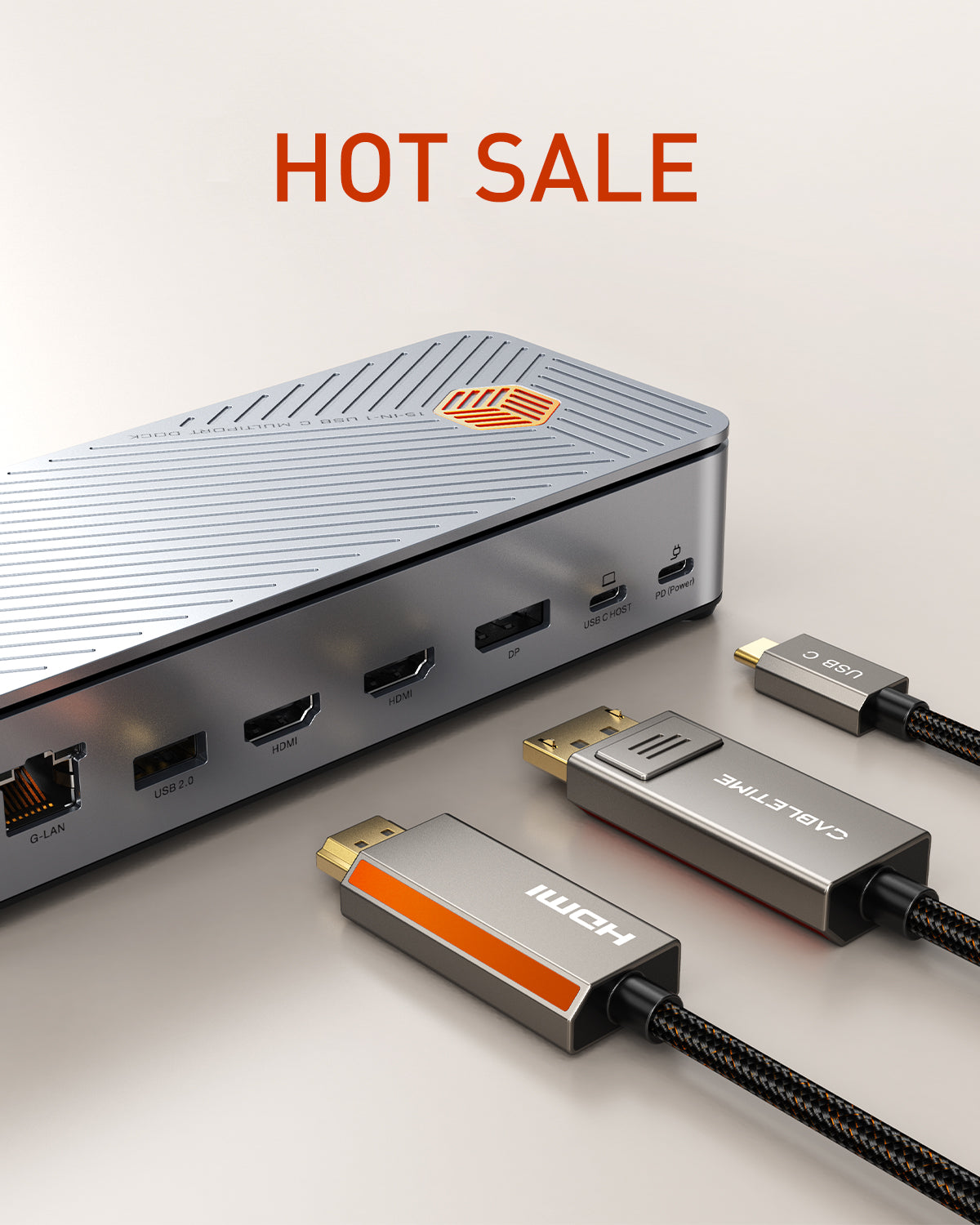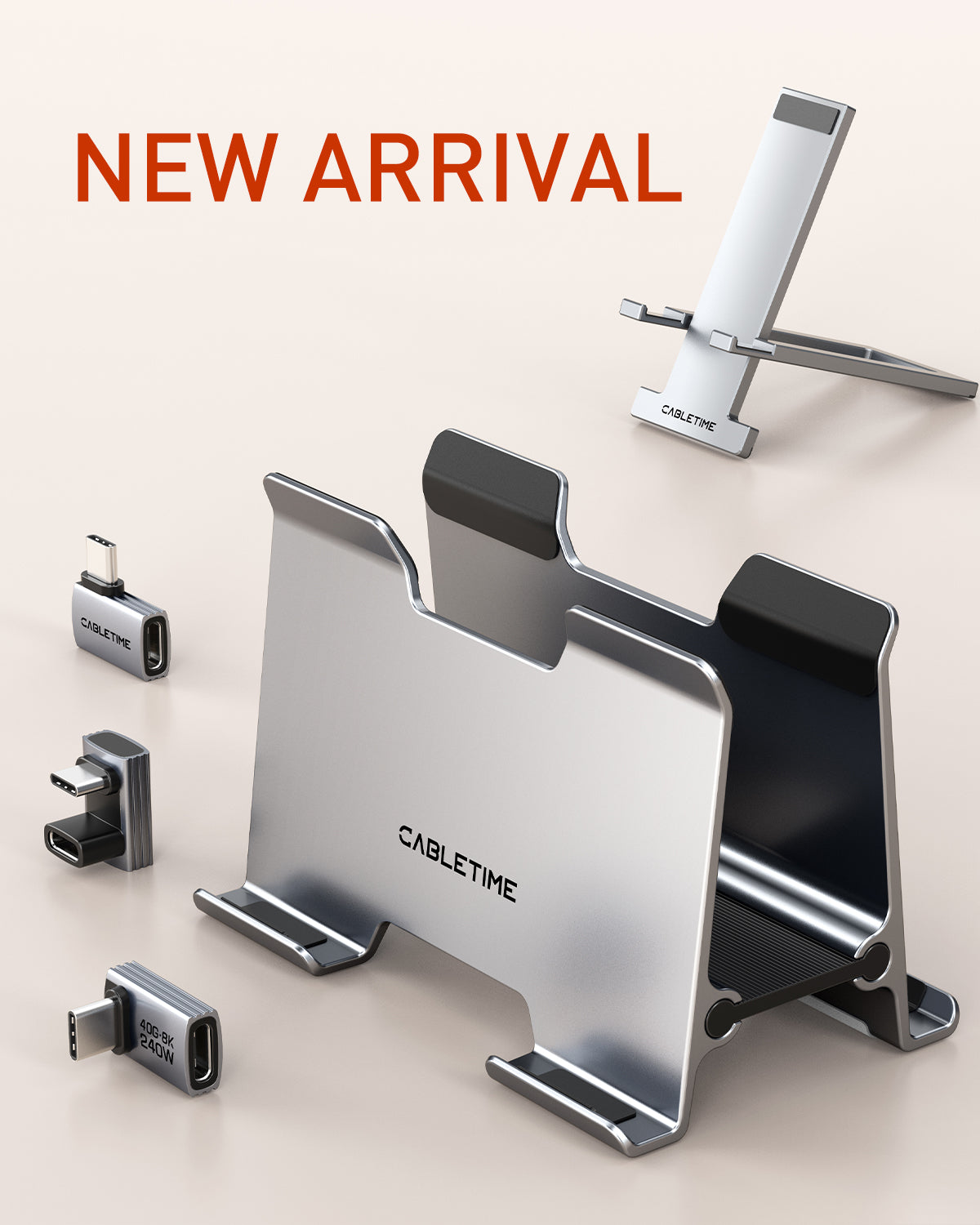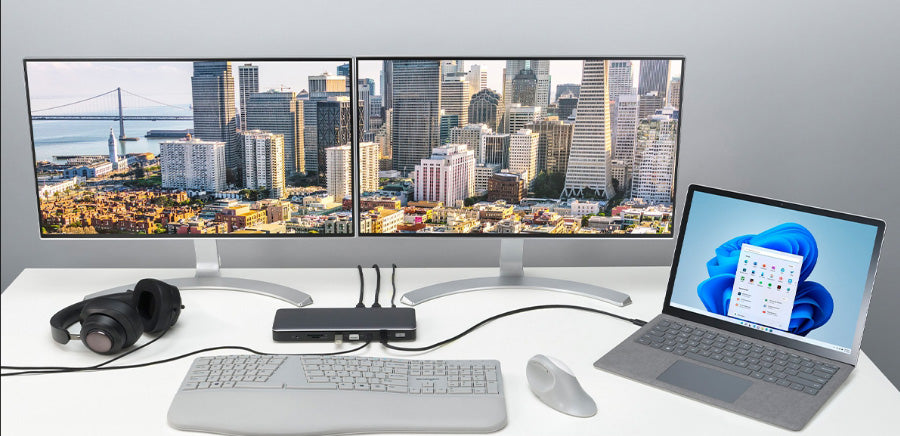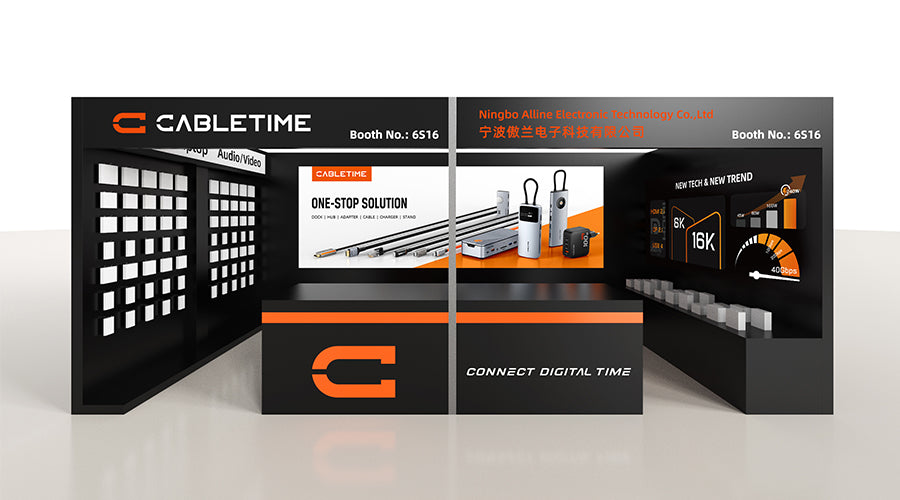Ricordi quando le tue battaglie quotidiane erano connettori non abbinati, cavi aggrovigliati e caricatori lenti e ostili? Quei giorni sono ormai lontani con l'introduzione dei caricatori USB C, che dominano oltre 2 miliardi di dispositivi attivi in tutto il mondo. Unifica il panorama della ricarica tra smartphone, laptop, tablet e probabilmente ogni gadget che puoi trovare.
USB C ha fatto molta strada. La prima versione USB 1.0 poteva solo caricare lentamente con i suoi limitati 500 mA (milliampere) a 5 V, che si traducevano approssimativamente in 2,5 W. Il loro standard iniziale mirava a fornire solo la ricarica della batteria USB. Al contrario, l'ultimo standard "USB Power Delivery" consente a USB C di caricare i dispositivi in modo bidirezionale, fornire uscita video, alimentazione e trasferire dati. Il nuovissimo Ricarica rapida USB-C connettore può raggiungere fino a 240W di potenza erogata. È sufficiente per alimentare una console di gioco o un monitor e fornire contemporaneamente segnali video e dati.
L'adozione diffusa è dovuta principalmente al suo connettore reversibile che ha reso la ricarica e la connessione dei dispositivi fluide. La sua rapida crescita e il design open standard hanno portato Apple ad abbandonare la sua porta lightning e ad adottare un connettore Type-C.
Questa guida svelerà la ricarica moderna, esplorandone la tecnologia, le caratteristiche e come scegliere il caricabatterie perfetto per le tue esigenze. Ti aiuterà a sviluppare una comprensione più approfondita dell'erogazione di potenza, del rischio di utilizzare cavi USB C di bassa qualità e delle tendenze future come l'integrazione della ricarica wireless.
Indice dei contenuti
- 1. Comprendere USB C e i suoi vantaggi
- 2. Gli aspetti tecnici della ricarica USB-C
- 3. Informazioni su cavi e connettori
- 4. Come USB C sta rivoluzionando la ricarica dei dispositivi
- 5. Selezione del caricabatterie USB C perfetto per le tue esigenze 300
- 6. Le migliori scelte per i caricabatterie USB C
- 7. Idee sbagliate comuni e domande frequenti sui caricabatterie USB C
- 8. Conclusion
Capire USB C e i suoi vantaggi
Lo sviluppatore di USB C, USB-IF, è un'organizzazione senza scopo di lucro che conta più di 1000 membri.Queste aziende associate a USB-IF hanno introdotto il design semplice ma versatile della porta e del connettore USB C nell'agosto 2014. L'ultimo connettore Type C a 24 pin è l'ultima aggiunta al suo design universale.
Rispetto alle versioni precedenti, il tipo USB C presenta numerosi vantaggi. Ecco le tre aree principali in cui l'ultimo connettore surclassa i tipi precedenti:
- Velocità: L'aumento di velocità ha l'impatto più significativo sulle prestazioni complessive di una connessione USB. Se confrontiamo un USB 2.0 di tipo C con l'ultima versione USB 4.0, le velocità di trasferimento dati sono passate da 480 Mbps a 40 Gbps per USB4. L'aumento di velocità sblocca le capacità di fornire protocolli video di fascia alta come HDMI e DP che supportano eARC, Dolby Vision, Dynamic HDR e VRR.
- Energia: Man mano che la versione di USB cambia, anche il design del connettore e della porta cambia per adottare le ultime funzionalità. L'erogazione di potenza richiede fili extra all'interno di un cavo e l'aggiunta di pin sul connettore. Il vecchio connettore USB C a 4 pin di USB 2.0 poteva gestire solo 2,5 W. In confronto, l'ultimo connettore a 24 pin può erogare 240 W USB PD.
- Versatilità: Uno dei vantaggi più significativi di avere un connettore USB-C è la sua ampia diffusione. L'ultimo connettore USB C con protocollo USB 4 può incanalare i protocolli DisplayPort Alt Mode o USB Video Class (UVC), offrendo fino a 8K@60Hz video e trasmissione audio. Può spingere le corsie PCIe per schede grafiche o di espansione esterne/portatili. Oltre a tutte queste caratteristiche, è retrocompatibile con le versioni precedenti.
Errore: [31m La funzione Parser di tipo "header1" non è definito. Definisci le tue funzioni parser personalizzate come: [34mhttps://github.com/pavittarx/editorjs-html#extend-for-custom-blocks [0m
Gli aspetti tecnici della ricarica USB-C
Approfondiamo gli aspetti tecnici che potenziano le capacità di ricarica USB-C. Ti sei mai chiesto come un singolo caricabatterie USB-C possa funzionare su più dispositivi? Il caricabatterie regola senza problemi la ricarica con dispositivi di qualsiasi capacità della batteria. La risposta è come ogni caricabatterie negozia l'erogazione di potenza al dispositivo connesso in base a tensione e corrente.
Il processo di ricarica
Non appena il dispositivo e il caricabatterie si collegano, iniziano a comunicare. L'intero processo avviene in tre fasi.
- Collegamento e identificazione: I dispositivi si scambiano informazioni sulle loro capacità, come i livelli di tensione e corrente supportati.
- Richiesta e risposta di potenza: In base alle esigenze del dispositivo, invia una richiesta di alimentazione e il caricabatterie risponde con un messaggio di conferma dei livelli di tensione e corrente.
- Erogazione e monitoraggio dell'energia: Dopo l'avvio dell'erogazione di potenza, sia il caricabatterie che il dispositivo iniziano a monitorare le loro condizioni. Possono modificare la tensione e gli ampere in base alla temperatura, allo stato della batteria e ad altre anomalie in uno dei due dispositivi.
Requisiti di potenza in watt dei diversi dispositivi
Ogni dispositivo potrebbe richiedere wattaggi unici in base al design e allo stato della batteria. USB PD ha uno Standard Power Range (SPR), che consente il funzionamento tra +5 V e +20 V. USB-IF ha sviluppato l'ultimo Power Delivery 3.1 Type-C e l'Extended Power Range (EPR) a +48 V, consentendo un'alimentazione di 240 W. Ecco una tabella che rappresenta tutti i livelli di tensione e potenza supportati da USB C:

Il fabbisogno energetico può variare a seconda del dispositivo. Uno smartphone tipico richiederà tra 20 e 50 W di potenza per la ricarica. I laptop potrebbero richiedere tra 20 e 100 W. Smartwatch, auricolari e mouse wireless potrebbero richiedere 5-10 W.Considerata la versatilità di un caricabatterie USB C di fascia alta, questo può supportare qualsiasi dispositivo di ricarica e fornire la potenza richiesta.
USB-IF controlla rigorosamente la capacità di ricarica dell'USB C tramite il suo standard Power Delivery (PD).
Informazioni su cavi e connettori
Il caricabatterie USB C funzionerà secondo le specifiche una volta che funzionerà con il cavo compatibile. Pertanto, è fondamentale sviluppare una solida conoscenza di cavi e connettori. Un cavo può avere un numero variabile di pin e materiale del connettore a seconda della sua capacità di erogazione di potenza.
Il numero di pin è il requisito principale di un caricabatterie USB C, in quanto suddivide l'erogazione di potenza su più pin per evitare di danneggiare il cavo. I produttori di cavi contraffatti proclameranno un'erogazione di potenza elevata, ma potrebbero non avere la qualità del materiale necessaria per resistere al carico. Ecco perché è essenziale identificare un cavo autentico.
Identificazione dei cavi USB C autentici
Riconoscere Cavi USB C richiede un'attenta valutazione dell'imballaggio e della presenza del logo USB certificato sulla confezione. USB-IF controlla rigorosamente la qualità dei fili tramite un rigoroso processo. Le aziende che utilizzano prodotti USB pagano commissioni per i loghi e le certificazioni USB-IF. Vediamo come USB-IF approva un prodotto USB certificato.
- Test di conformità: Il prodotto deve superare il test in laboratorio presso USB-IF.
- Contratto di licenza del marchio: Condizioni d'uso del logo e dei marchi USB-IF.
- Commissioni: Le tariffe per i test e le licenze variano in base al tipo di prodotto, al numero di loghi, ecc.
- Verifica: Dopo l'accordo e il pagamento delle tariffe, USB-IF garantisce la conformità e consente l'uso dei loghi ufficiali sul prodotto.
- Elenco dei prodotti: Il prodotto viene finalmente menzionato pubblicamente per trasparenza nell'elenco degli integratori USB-IF.
Ecco i passaggi che puoi seguire per garantire l'autenticità di un cavo certificato:
- Loghi ufficiali: Cerca i loghi ufficiali USB sulla confezione e sul cavo vero e proprio. Ecco una tabella che identifica tutti i loghi autentici.

- Cerca nel database USB-IF: L'acquirente può ulteriormente garantire l'autenticazione controllando il prodotto "USB-IF Certified TID" sul Banca dati USB-IF.
- Chip E-Marker: I cavi che forniscono più di 5A incorporano un chip E-Marker. Questi cavi sono costosi e il produttore menziona un chip E-Marker sul prodotto o sulla sua confezione.
- Qualità costruttiva: Esaminare la qualità del cavo e del connettore. Il connettore è solitamente un grande indizio nei cavi contraffatti. Il connettore potrebbe avere parti o connessioni allentate.
Rischi dell'utilizzo di cavi contraffatti di bassa qualità
Utilizzare un cavo di bassa qualità può essere pericoloso per la tua attrezzatura e la tua sicurezza personale. Un'erogazione di potenza di 100 W, 240 W o superiore tramite USB C è significativa per causare una scossa elettrica. Ecco i tre fattori che l'utilizzo di un cavo di bassa qualità influenzerà direttamente:
- Prestazione
- Rischio di incendio
- Rischio per la sicurezza elettrica
Come USB C sta rivoluzionando la ricarica dei dispositivi
L'uso di un design a porta singola e di caratteristiche di carica in tutti i dispositivi elettronici è rivoluzionario. Molteplici organizzazioni normative e di ricerca associate, come la Commissione Europea, la Consumer Electronics Association e il Programma delle Nazioni Unite per l'Ambiente, affrontano l'impatto dell'omogeneizzazione della carica.
Immagina di usare un singolo caricabatterie USB-C per il tuo smartphone, laptop, tablet o altri dispositivi elettronici. Ogni casa ha già dei caricabatterie elettronici, ma USB C standardizzerà le prese a muro con porte di ricarica standard.
Caso di studio: impatto dell'USB-C sulle abitudini di ricarica di laptop e smartphone
Le crescenti capacità di erogazione di potenza USB-C hanno consentito ai laptop di utilizzarla per la ricarica e l'alimentazione. La sua diversità, che consente la trasmissione video e il trasferimento dati su un design con porte di piccole dimensioni, ha convinto i produttori di laptop a includere porte USB-C. I laptop possono utilizzare una singola porta per più scopi, riducendo la necessità di porte dedicate. Secondo un rapporto pubblicato da IDC nel 2022, il mercato globale dei laptop USB-C raggiungerà i 58 miliardi di dollari entro il 2026.
Allo stesso modo, ha avuto un impatto significativo sul modo in cui carichiamo i nostri smartphone. Strategy Analytics ha segnalato che il mercato globale degli smartphone USB-C è cresciuto dell'88% anno su anno nel 2021, indicando una rapida adozione di questa tecnologia da parte dei consumatori. Il motivo della crescita rimane lo stesso: design compatto della porta con versatilità nella comunicazione.
Tendenze future: integrazione USB C con ricarica wireless
Abbiamo già la ricarica wireless Qi come standard per la ricarica dei dispositivi, e spesso utilizza USB-C come fonte di alimentazione. Le capacità di USB PD 3.1 hanno un impatto significativo sul panorama della ricarica wireless. Il potenziale della ricarica wireless e dell'integrazione USB-C è immenso.
Ricarica ibrida: Immagina di appoggiare il tuo smartphone su un tavolo e che inizi a caricarsi senza doverlo collegare. E più dispositivi? Alcuni prodotti stanno già caricando i dispositivi in modalità wireless. Man mano che sempre più dispositivi elettronici adottano la ricarica wireless, passare da un dispositivo all'altro e distribuire l'alimentazione in modo intelligente tramite caricabatterie USB C e Qi diventerà la norma.
Spinta normativa: I governi e gli enti normativi stanno spingendo per soluzioni di ricarica universali, che potrebbero portare all'adozione dell'USB C come standard.
Ricarica intelligente:Con l'adozione da parte di sempre più dispositivi dello standard USB C, aumenterà la complessità necessaria per adattare l'alimentazione in base allo stato del dispositivo, all'ambiente, all'utilizzo e all'efficienza di ricarica.
Il ruolo dell'USB C nelle soluzioni di ricarica sostenibili
La versatilità dell'USB C lo rende una soluzione ideale all'aumento globale dei rifiuti elettronici. I dispositivi che consumano molta energia stanno influenzando il modo in cui generiamo rifiuti. La quantità di plastica e rifiuti tossici che finiscono nelle discariche è sorprendente. Secondo una ricerca di Statista del 2018, ci sono circa 121 milioni di caricabatterie per telefoni inutilizzati solo negli Stati Uniti!
La necessità di cambiare costantemente caricabatterie a causa dell'incompatibilità tra i dispositivi sta causando un sacco di rifiuti elettronici. USB C è una solida risposta al problema crescente. Ecco alcuni documenti pubblicati da organizzazioni di buona reputazione in tutto il mondo, che evidenziano l'importanza dei caricabatterie universali:
- "Armonizzazione dei caricabatterie per telefoni cellulari: impatti economici e ambientali" della Commissione europea.
- "L'impatto di una politica di caricabatterie universale sulla comodità e sui costi per i consumatori" della Consumer Electronics Association.
- "Caricabatterie universali: opzioni politiche per ridurre i rifiuti elettronici e promuovere l'interoperabilità" del Programma delle Nazioni Unite per l'ambiente.
Selezione del caricabatterie USB C perfetto per le tue esigenze 300
Ora che conosciamo tutti i retroscena tecnici dei caricabatterie USB C e come modellano il mondo, possiamo immergerci nella guida per selezionare il caricabatterie perfetto. Acquistare un caricabatterie USB qualsiasi per iniziare a caricare il tuo dispositivo non è l'ideale.Ecco una guida passo passo per scegliere il caricabatterie USB C più adatto alle tue esigenze:
Guida passo passo per scegliere il caricabatterie USB C ideale
Fase 1: Valuta i tuoi requisiti
- Indica se hai bisogno di più di una porta di ricarica su un caricabatterie per più dispositivi.
- Considera il requisito di ampere/voltaggio del tuo dispositivo. Se ha un processore Qualcomm, il caricabatterie deve essere certificato QC. Altrimenti, funzionerà un caricabatterie USB-C PD standard.
Passaggio 2: trova un caricabatterie certificato
- Trova il logo certificato sulla confezione del caricabatterie e sul caricabatterie stesso. USB-IF controlla i loghi, testa il prodotto e ne garantisce la qualità prima di fornirgli un TID certificato USB-IF.
- Cercare le certificazioni di sicurezza UL, CE e FCC.
Passaggio 3: considerare tutti i fattori
- Tecnologia GaN: si tratta di caricabatterie basati su nitruro di gallio anziché silicio. Consente ai produttori di costruire unità di ricarica più piccole e di adattarle a più porte.
- Marchio: Cerca un marchio che abbia una buona reputazione. Cerca recensioni online e acquista tramite un sito di e-commerce affidabile o una pagina ufficiale.
- A prova di futuro: un caricabatterie rapido con certificazione USB-C PD 3.1 da 240 W funzionerà in modo efficiente anche per un dispositivo con batteria di piccole dimensioni. Può funzionare su più dispositivi con porta USB-C.
- Adatto ai viaggi: se viaggi spesso, tieni in considerazione la compattezza del dispositivo.
Passaggio 4: fai le tue ricerche
- Prima di valutare un prodotto è fondamentale considerare tutti i fattori.
- Visita più pagine prodotto ed esegui confronti.
- Per prendere una decisione, considerare il rapporto prezzo/prestazioni.
Le migliori scelte per i caricabatterie USB C
Per semplificare il processo di selezione, ecco alcuni dei nostri migliori consigli per caricare i tuoi dispositivi elettronici di uso quotidiano:
Caricabatterie da muro GaN PD3.0 3C1A 100W CABLETIME G100B

Punti salienti principali
- Alimentazione standard USB C 3.0
- Erogazione di potenza da 100 W tramite una singola porta USB C
- Ampere e voltaggio adattabili per infinite possibilità
- Tecnologia GaN per un design compatto ed efficiente
TEMPO DI CAVO presenta la soluzione di alimentazione definitiva per tutti i tuoi gadget in un piccolo fattore di forma. Collega quattro dispositivi per caricarli contemporaneamente, riducendo la necessità di più adattatori di alimentazione. Collega quattro dispositivi contemporaneamente, dai laptop agli smartphone, e guardali rianimarsi in pochi minuti grazie al fulmineo Power Delivery 3.0 da 100 W.
È un'eccellente alternativa agli ingombranti adattatori. Grazie alla sua infrastruttura GaN (nitruro di gallio), l'adattatore è compatto con migliori caratteristiche termiche ed efficienza. L'adattatore comunica con i dispositivi e seleziona una tensione e un ampere specifici che si adattano perfettamente al dispositivo. La capacità di fornire un'ampia gamma di uscite di potenza porta a una migliore durata della batteria del dispositivo.
Infila questa potenza tascabile nella tua borsa o nella tua borsetta e connettiti a qualsiasi rete elettrica del mondo. Ricarica il tuo dispositivo da 100 W e un amico da 15 W dalla stessa porta. Resta alimentato ovunque tu vada!
Specifiche tecniche
- Modello: S-TR-306B-EU
- Tensione di ingresso
110V-240V~,50/60Hz 3,0A massimo
- Configurazioni di uscita PD da 100 W
C1/C2: 5,0 V--3,0 A 9,0 V--3,0 A 12,0 V--3,0 A 15,0 V--3,0 A 20,0 V--5.0A 100,0 W
USB C3: 5,0 V--3,0 A 9,0 V--3,0 A 12,0 V--2,5 A 30,0 W
- Uscita USB A
UN: 5,0 V--3,0 A 9,0 V--3,0 A 12,0 V--2,5 A 30,0 W
- Possibili configurazioni di potenza
C1/C2: 100,0 W
C1+C2:65,0W+30,0W
C1/C2+USB-A:65,0 W+30,0 W
C1/C2+C3:65,0 W+30,0 W
C1+C2+C3:40,0W+18,0W+30,0W
C1+C2+USB-A:40,0 W+18,0 W+18,0 W
C1+C2+C3+USB-A:40,0 W+18,0 W+9,0 W+9,0 W
- Dimensioni: Dimensioni: 67 x 64 x 31 mm
- Standard: europeo
Caricabatterie da muro GaN PD3.0 20W CABLETIME GA20B

Punti salienti principali
- Dimensioni tascabili: 31 mm
- Tecnologia PD 3.0 più recente da 20 W
- Porta USB C robusta
- Progettazione di potenza basata su GaN
Ecco il caricabatterie da muro CABLETIME GaN PD3.0 da 20 W (GA20B), il miglior adattatore di alimentazione USB C tascabile che migliora la praticità della ricarica mobile. Il suo design compatto, che misura appena 31 x 32 x 31 mm, si adatta senza sforzo a qualsiasi borsa o tasca, eliminando la necessità di ingombranti adattatori. Nonostante le sue dimensioni, il GA20B è un concentrato di potenza con la sua tecnologia Power Delivery (PD) 3.0 da 20 W.
Questo standard all'avanguardia garantisce una ricarica rapida per vari dispositivi, dagli smartphone e tablet ai laptop. Il GA20B può ricaricare il tuo iPhone 13 Pro Max al 50% in 30 minuti. La sua ampia gamma di tensione di ingresso di AC100-240V consente un utilizzo globale senza interruzioni, mentre le sue molteplici configurazioni di uscita PD soddisfano le diverse esigenze dei dispositivi. L'adattatore si adatta automaticamente alla configurazione di tensione e ampere del dispositivo per caricare o alimentare in modo efficiente. Ha opzioni di alimentazione da 5 V/3 A (15 W), 9 V/2,224 A (20 W) o 12 V/1,674 A (20 W) per fornire una potenza ottimale al tuo gadget.
La tecnologia Premium Gallium Nitride (GaN) assicura che il caricabatterie funzioni a temperature più basse, aumentando l'efficienza e prolungandone la durata. Quindi, abbandona gli ingombranti adattatori e abbraccia la potenza tascabile: il caricabatterie da parete CABLETIME GaN PD3.0 20W (GA20B).
Specifiche tecniche
- Tensione di ingressoAC100-240V, 50-60Hz, 0,5A massimo
- Configurazioni di uscita PD da 20 WTipo C: 5 V/3 A (15 W), 9 V/2,224 A (20 W), 12 V/1,674 A (20 W)
- Dimensioni: Dimensioni: 31x32x31mm
- Standard: europeo
Idee sbagliate comuni e domande frequenti sui caricabatterie USB C
D: Tutti i caricabatterie USB C sono uguali?
No, non tutti i caricabatterie sono multiuso. Alcuni sono mirati a dispositivi specifici. È essenziale cercare certificazioni che supportino la tecnologia USB PD. I requisiti del dispositivo vanno da una carica di mantenimento da 2,5 W a una carica rapida da 240 W. È necessario analizzare i requisiti del dispositivo e assicurarsi che il caricabatterie abbia la certificazione per soddisfarli.
D: L'USB-C può danneggiare la batteria del dispositivo?
I dispositivi moderni hanno varie protezioni integrate nel caricabatterie e nell'hardware/software del dispositivo. Finché utilizzi un caricabatterie USB C o QC certificato, non devi preoccuparti di danneggiare la salute della batteria. Tuttavia, un caricabatterie contraffatto può danneggiare la batteria fornendo tensioni o correnti incompatibili.
D: Posso usare qualsiasi cavo USB-C con il mio caricabatterie?
In genere, qualsiasi cavo USB C può funzionare con qualsiasi dispositivo, ma ci sono dei rischi. Un cavo di bassa qualità o contraffatto può comportare rischi per la sicurezza e di incendio.Il materiale potrebbe non gestire il carico termico a wattaggio maggiore. Quindi, usare un cavo certificato da USB-IF, QC o un'organizzazione affidabile è fondamentale.
D: Anche con un caricabatterie USB-C, il mio dispositivo impiega un'eternità. Cosa c'è che non va?
Diversi fattori possono influenzare la velocità di ricarica: la potenza in watt del caricabatterie, il cavo che stai utilizzando e le limitazioni di potenza del tuo dispositivo. Assicurati di utilizzare un caricabatterie con una potenza in watt adeguata per il tuo dispositivo e un cavo certificato. Alcuni dispositivi danno priorità alla salute della batteria rispetto alla velocità, quindi si verificherà un tempo di ricarica più lento.
D: Posso lasciare il mio dispositivo sempre collegato alla corrente?
I dispositivi moderni hanno caratteristiche intrinseche per prevenire il sovraccarico, quindi lasciarli collegati è generalmente sicuro. Tuttavia, è meglio evitare di tenere il dispositivo al 100% di carica per periodi prolungati per una salute ottimale della batteria. Lasciare che la batteria si scarichi al 20-30% prima di ricaricarla è l'ideale.
Conclusione
Garantire che la salute personale e del dispositivo rimanga intatta è fondamentale per utilizzare prodotti certificati. I produttori che vendono prodotti accreditati potrebbero avere prezzi più alti rispetto ai prodotti contraffatti a causa dei costi associati alle certificazioni. Nella ricarica USB-C, assicurarsi che il caricabatterie e il cavo siano certificati da USB-IF o QC è fondamentale per garantire una ricarica sicura ed efficiente. Per riassumere, ecco i punti principali della nostra linea guida:
- Utilizzare sempre un caricabatterie e un cavo USB C certificati. Cercare i loghi e i PID USB-IF certificati.
- I caricabatterie basati su GaN sono i migliori perché hanno un design compatto e una buona dissipazione del calore.
- USB-IF e il design USB C rappresentano il futuro della trasmissione di dati, video, audio e alimentazione.
- Gli enti regolatori puntano a un metodo di ricarica universale per ridurre i rifiuti elettronici. Ciò rende USB C il candidato migliore come soluzione unica per tutte le esigenze elettroniche.
- L'adozione della tecnologia USB C è a prova di futuro e la sua diversità non è equivalente.
Nel complesso, il nostro obiettivo in tutte le linee guida è garantire che i nostri lettori investano in un caricabatterie USB C adatto e siano soddisfatti delle sue prestazioni. Investi sempre in un caricabatterie e un cavo di alta qualità certificati per prestazioni e sicurezza ottimali. Quindi perché aspettare? Trasforma la tua casa in un luogo a prova di futuro e acquista subito un caricabatterie e un cavo USB C certificati!






Lascia un commento
Questo sito è protetto da hCaptcha e applica le Norme sulla privacy e i Termini di servizio di hCaptcha.